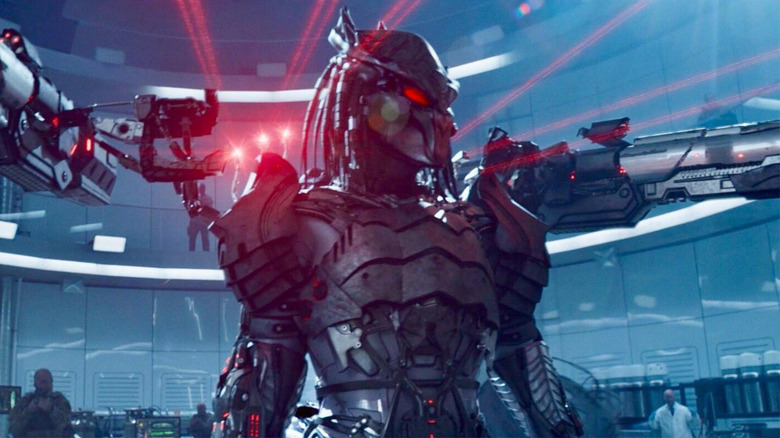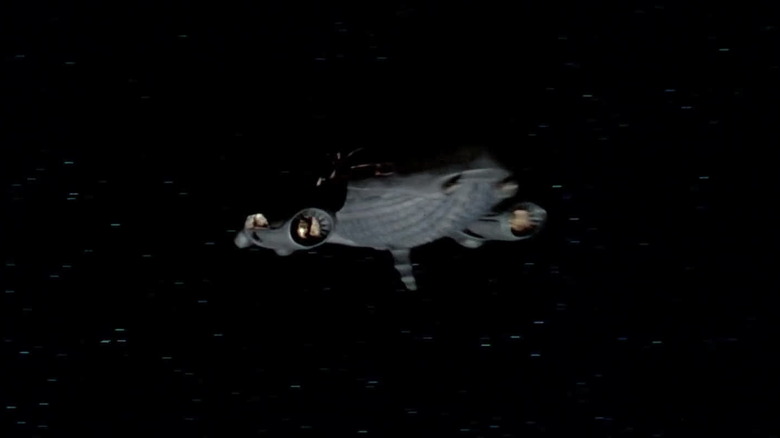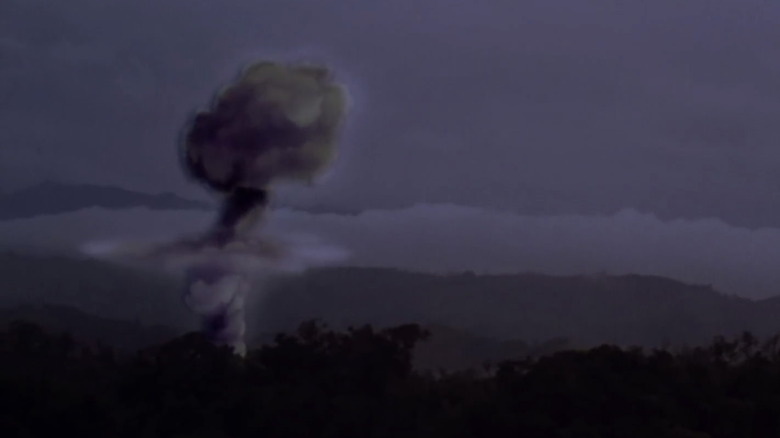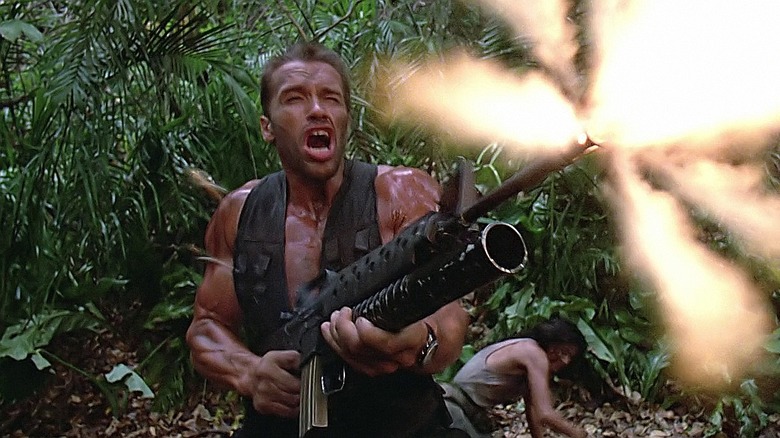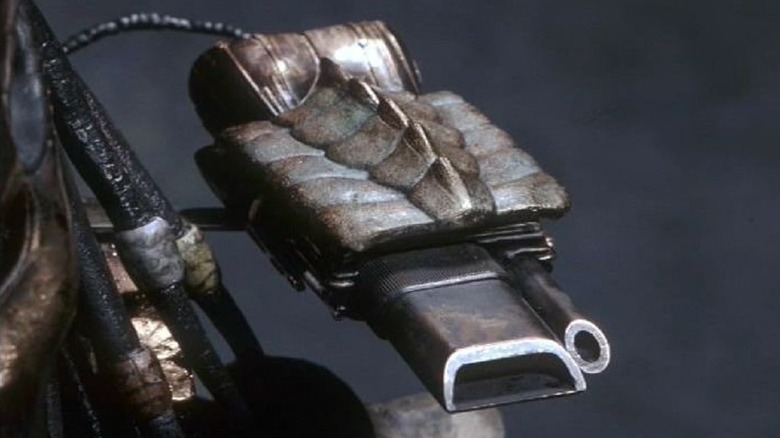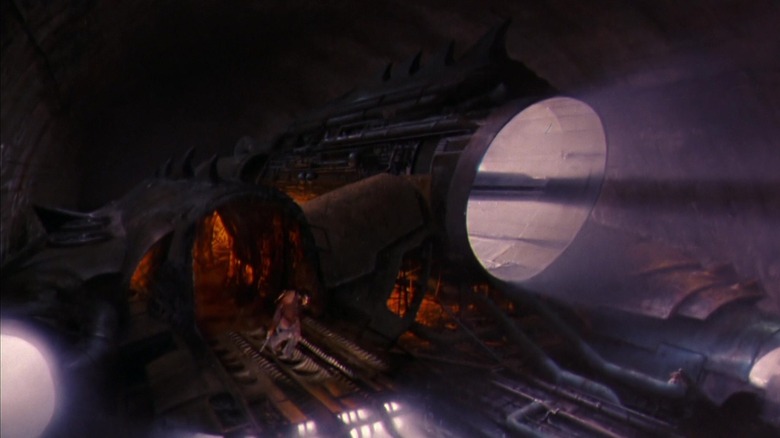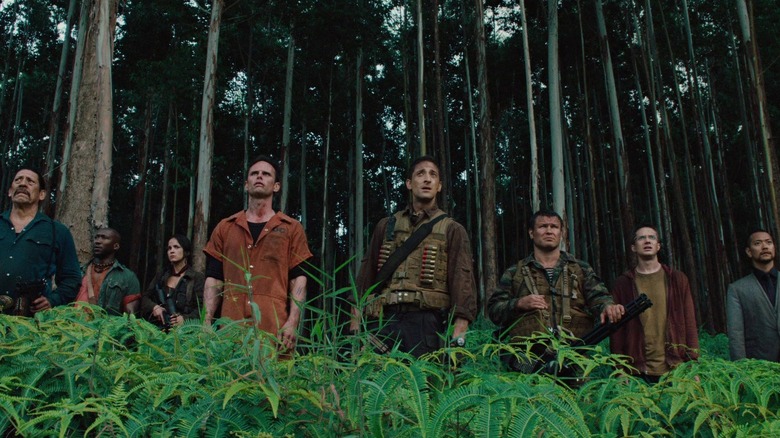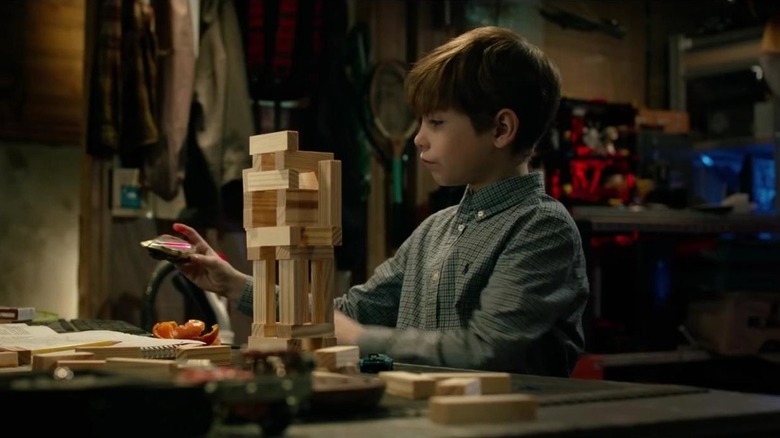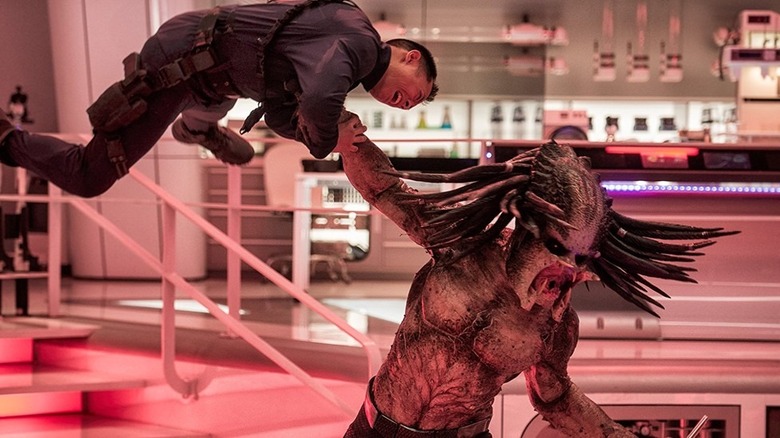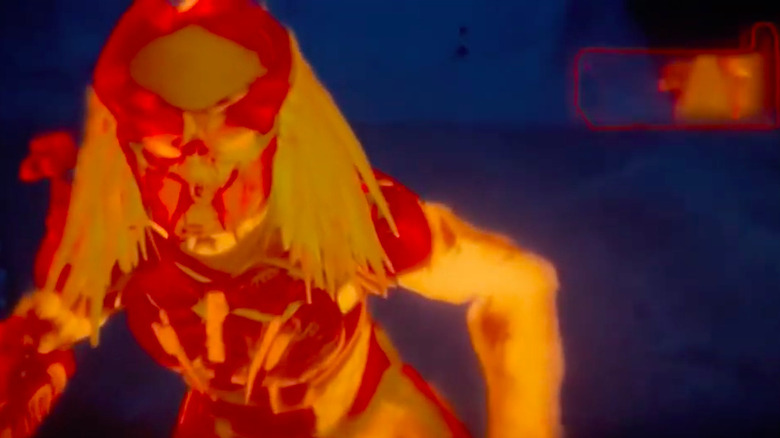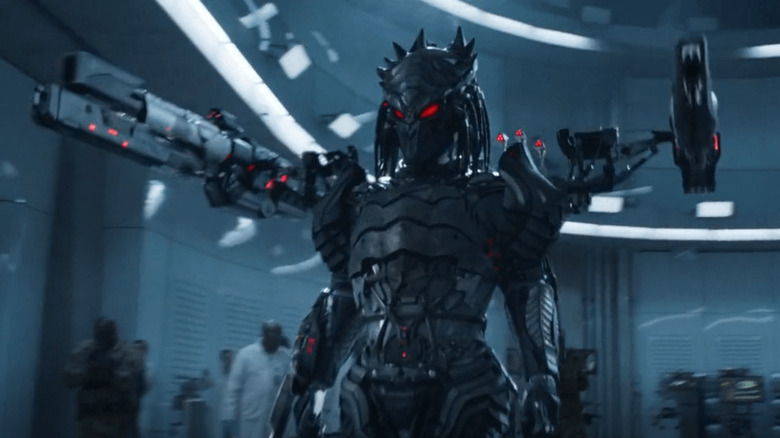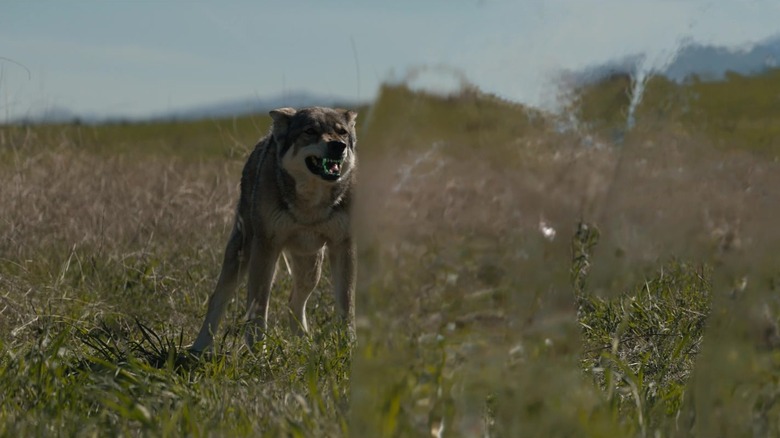11 Things About The Predator Series That Make No Sense
Although never named in any entries of the franchise, the deadly aliens in the "Predator" series are a species called the Yautja (pronounced "Yah-OOT-Cha"). The films themselves do little to explain where they come from and what their civilization might be like. What little we know is based on seeing a few of them as intergalactic big-game trophy hunters, but is this true of their entire society? Is their civilization centered around the hunt? Or are the Predators we've seen pariahs, the Yautja equivalent to big-game trophy hunters like Walter Palmer, widely criticized for his participation in the controversial killing of both Cecil the lion and a protected ram in Mongolia?
In 2010's "Predators," Royce (Adrien Brody) quotes Hemingway, "Certainly there is no hunting like the hunting of man and those who have hunted armed men long enough and liked it, never really care for anything else thereafter." Like us, he and other on-screen characters are speculating. Being literal aliens, we must assume their motivations and reasoning are also alien. That's a convenient excuse for the Yautja to behave any which way convenient to the story.
But audiences are human beings with human insights and perspectives, and we expect stories and what occurs in them to make some kind of sense to us. From that human perspective, there are definitely some things that make no sense in the Predator franchise.
The fate of the Jungle Predator's ship
One big loose end in the original "Predator" is the spaceship that brought the Jungle Predator (Kevin Peter Hall, who replaced Jean-Claude Van Damme) to Earth. One presumes it's parked in the jungle near the wrecked helicopter that Dutch (Arnold Schwarzenegger) and company find in the trees, and near the route from the camp they attacked and their pickup point. A Predator's gotta take his trophies somewhere, right?
Several things about this don't make a lot of sense. We barely see the ship at the top of the film, so we have no frame of reference for its apparent size. But we're assuming it's at least as big as a school bus, and that's not an easy thing to park in a jungle as dense as what's portrayed. And what happened to it? When the dying Predator activates his gauntlet's self-destruction, the resulting explosion seen from the helicopter is just one smallish mushroom cloud, suggesting the ship is still out there. But why didn't it blow up, too?
The film has no answers, but an April 7, 1985 shooting script (then-titled "Hunter") concluded differently: Dutch followed the wounded alien back to its camp, where he spies his foe entering its nearly invisible spacecraft. He activates the Predator's dropped weapon and it rockets into the closing hatch of the spacecraft, resulting in a single explosion that blew all traces of the ship and pilot to fine ash. That ending sensibly tied up any loose ends, but the one we got... not so much.
The 300-block boom self-destruction in Predator
Speaking of that ship explosion, in "Predator 2," Special Agent Peter Keyes (Gary Busey) describes the explosion from "Predator" as destroying an area of rainforest equivalent to 300 city blocks; a blast radius of something on the order of 1,000 meters. If the Predators blow themselves up to avoid revealing their presence on Earth, isn't flattening a two-kilometer circle counterproductive? Why such a giant blast? An uncontrolled (presumably) interstellar spaceship explosion taking out a large area, sure. But not a personal self-destruction.
One can argue the mushroom cloud seen at the end of the first film was the ship going up separate from its pilot, but even if that were the case, isn't a blast of that size likely to draw unwanted attention? Are the Yautja concerned about humanity at-large learning about their hunting trips? If so, flattening a two-kilometer area is a terrible way to avoid detection, especially when that ship is in a major urban environment, as in "Predator 2." One would assume the ship would auto-pilot into orbit before going kaboom, avoiding troubling questions
Endless ammo supplies in Predator
Admittedly, this issue isn't unique to the "Predator" series. Movies often depict characters firing double-barreled shotguns more than twice without reloading, or having a six-shooter spit out 11 consecutive bullets. But the seemingly limitless sprays of bullets in the original "Predator" make no sense.
The most memorable weapon from "Predator" is "Ol' Painless," wielded by Blain Cooper (Jesse Ventura). It was a modified M134 minigun designed for aircraft, weighing 85 pounds, with a firing rate of 2,000 to 4,000 rounds per minute. For those keeping count, 90 seconds of ammunition at the minimum firing rate — minus ammo boxes — would weigh over 200 lbs (92 kg). Such a beast would require so much ammo that even big-bad Blaine couldn't lug it. The other members of the ill-fated mission carry somewhat less preposterously overboard weaponry, but it never appears that any of them lug enough ammo for what we see fired.
Funnily enough, 2010's "Predators" unintentionally hangs a lantern on this when Royce (Adrien Brody) says, "We've got to conserve ammunition," just after the group sprays a zillion bullets at the Hell-Hounds.
The Overkill Weapons of the Predators
The Predator timeline covers centuries, and "Prey" Director Dan Trachtenberg wisely used that film's early 18th-century milieu to simplify the Predator's arsenal, yet maintained a delicate balance to make sure it still felt very advanced and very beyond earthly capability and ensured the "new" Predator weapons never made things easier for Naru (Amber Midthunder). But the series hasn't always gotten the balance right.
It's a given that Predators are big-game trophy hunters specifically focused on obtaining impressive specimens for display. We've seen they typically don't hunt defenseless or child-bearing humans. That provides at least a glimpse into what they believe constitutes good sports-thing-ship. Whatever governs that isn't what we — at least in our current culture — would consider ethical, especially injuring or killing those that aren't specifically their target. Their use of high-tech sensors is equivalent to the unsporting human hunting practice of "spotlighting," which uses artificial lights to hunt nocturnal animals.
Indeed, some weapons seem like overkill for mere hunting purposes, and a Yautja's use of force can be disproportionate to the prey in question, rather like hunting a rabbit with an elephant gun. It's one thing to use a shoulder cannon to take out Ol' Painless-wielding Blain. It's quite something else to use a homing weapon like the Smart Disk introduced in "Predator 2." Where's the skill in a weapon that can change course in flight? There isn't any.
Predator 2's sewer spaceship
The climax to "Predator 2" has Lieutenant Mike Harrigan (Danny Glover) track the mortally wounded City Predator (Kevin Peter Hall) into the Los Angeles sewers, whereupon he discovers the spaceship that brought it to Earth parked within. But how does a spaceship get into a sewer, let alone fit in one?
There are certainly massive sewer systems — the "Temple" of the Metropolitan Area Outer Underground Discharge Channel in Japan comes to mind — but although such things may feature vast, cavernous chambers, they typically aren't built with openings big enough to fly a spaceship into. One of the most enormous is the wastewater treatment Tunnel Emisor Oriente, in Mexico City, Mexico, with a diameter of 23 feet (7 meters). From what little we see of the ship's aft end and Harrigan for scale, the Predator ship is at least 50-feet wide, which might barely scrape through the ginormous spillway tunnels on the Hoover Dam.
At 28-feet wide, the old "Hollywood Subway" Belmont Tunnel used for filming the sewer entrance is not only far too small to accommodate such a vehicle (by more than 40%), but no effort is made to cheat the shot and make it look bigger than it actually is. Even if the ship could fit, was there room for it to turn around inside, or did it have to back in?
Specific prey selection in Predators
Throughout the franchise, Yautja typically select prey based on a combination of factors such as strength, skill, and the thrill of the hunt. They appear drawn to formidable opponents, targeting armed individuals or groups who pose a challenge and ignoring the unarmed. In the first two films in the franchise, the Predators hunt in war zones, rural or urban. Among the best and worst Predator fan theories, one proposes that City Predator of "Predator 2" targets drug lords specifically to entice a more formidable prey into joining the hunt: the feds.
But 2010's "Predators" mucks this up. It's one thing to hang around in hotspots where you expect challenging prey to be, rather like going on safari, and quite another to select specific individuals for transport to a game preserve world. How did the Predators pick their prey? Where's their intel coming from? Are the Predators watching Action 5 News to know about criminals? Are they somehow accessing military and police records? And how are they capturing them? The effort seems disproportionate to the challenge.
Worse, some of their choices are inexplicable. Case in point: Stans played by Walton Goggins. Sure, he's a convicted serial killer, but that's just being evil, not necessarily a challenging opponent. Worse, he's dropped into the hunt armed with only a shiv. A shiv! How is that a challenge to the Super Predators? The only potential threat to them would be in melee combat, not using their signature ranged weapons. Bad form, Yautja.
The Predator weaponizing Rory
Anyone who knows much of anything about Autism Spectrum Disorder (ASD) knows that when it's portrayed at all, movies and TV routinely get it all wrong and sensationalize it. "The Predator" falls prey (pun intended) to this nonsense, as it depicts Rory McKenna (Jacob Tremblay) as having savant-like abilities to decipher alien technology due to his ASD. It's a reductive, nonsensical portrayal that reduces Rory to a plot device rather than a well-developed character with agency and perpetuates harmful stereotypes that individuals with ASD possess extraordinary intellectual abilities, which is not representative of the diverse experiences within the autism community. In an article on his autism awareness website "Autistic & Unapologetic," James Ward-Sinclair described the depiction as "the most ill-informed, backhanded compliment our community will ever receive," and added, "the kind of autism they had in mind isn't representative of actual autism." That may be too kind.
Even taking the movie at face value and with a fantasy version of ASD, nothing that happens supports its junk science premise characterizing autism as "the next step of evolution." If the Predators are after human DNA to improve themselves, how the heck would Rory's ability to decipher their tech and language make them better hunters? It makes no sense.
The Fugitive Predator's jumbled motivations
An antagonist with inhuman perspectives is a double-edged sword narratively. The enigmatic nature of the Yautja maintains an air of mystery that keeps them from becoming stale, which is good, but conversely, it leaves their motivations unclear and confusing, which can be bad. The latter is the case with the Fugitive Predator, who crashes on Earth in "The Predator."
At best, its behavior seems inconsistent and contradictory. It comes to Earth with a pod bearing the so-called Predator Killer suit. There's a suggestion that it's giving it to humanity to help them prepare for an imminent invasion of their common foe. The Upgraded Predator refers to the Fugitive as the "traitor," which certainly implies the latter was trying to get the Predator Killer to humanity.
But if that's the case, why is the Fugitive so quick to slaughter humans? One can understand it violently attacking its keepers in the Project Stargazer facility, especially if it expects to be experimented on or dissected. But otherwise, why isn't it attempting to communicate the threat and point the humans to the suit? Is it a case of the "Scorpion and the Frog" fable that teaches that some are incapable of acting against their instincts or true nature, even if it leads to their own demise?
An alternate climactic battle was considered, in which the Fugitive would team up with the "Loonies," the film's main protagonists, but it was one of many scenes in the franchise that didn't make the cut.
The Upgrade Predator's non-helmet vision
It's difficult to imagine what The Predator movies would look like without special effects, especially the signature cloaking camouflage and infrared thermal vision, both courtesy of technology the Yautja wear. We know the latter are generated by their bio-helmets, because when a Predator loses its helmet, its point of view looks entirely different from any other visual mode depicted. Well, until "The Predator," anyway.
Two very different Yautja appear in that film. The first, the Fugitive Predator (Brian A. Prince), is equipped similarly to its cinematic predecessors: with armor, weapons, and bio-helmet thermal vision included. The second, the vastly larger Upgrade Predator (Kyle Strauts), eschews armor for an armored hide and wears no helmet at all. But when we see its point of view, what's depicted is effectively that same thermal vision ... complete with tactical overlays.
Given a major story point is that the Predators are upgrading themselves using the DNA of other beings, such genetic improvement seems at odds with implanting computer display gizmos in their eyeballs or connected to their optic nerves or whatever. It would be more consistent with the story's themes if they had developed the biological equivalent of such tactical overlays.
The Predator Killer suit
"That's my new suit, bubba. I hope they got it in a 42 long."
That's whatQuinn McKenna (Boyd Holbrook) says after witnessing the contents of the Fugitive Predator's pod latch onto a hapless Project Stargazer scientist, pulling an Iron Man-esque suit-up by forming into a ridiculous-looking Yautja-like suit of armor bristling with weapons before inexplicably folding back up again.
But just what is this thing, and who was it invented for? Heads aside, non-Upgraded Yautja bodies are roughly analogous to human ones, and when the suit forms around the scientist, it clearly customizes itself to fit. So how certain can we be it was specifically designed for humans to wear?
Yes, Rory translated its description as "Predator Killer," which certainly suggests it was made for human use. But if Yautja like the Fugitive are in conflict with the Upgrades, why aren't they making these for themselves? Or is this a case of the Predators living by some code of honor that we don't understand? They're clearly outclassed, as proven by how effortlessly the Upgrade kills the Fugitive. Maybe they're making these for themselves and this particular one's being gifted to humans? Or maybe no one making the movie really thought it through. There were certainly a variety of options considered for the surprise ending and the contents of the pod.
Strange animal behavior in Prey
For a film so widely praised for its accuracy about First Peoples, "Prey" doesn't portray wildlife accurately at all. It falls into the movie cliche that the wild kingdom is a murder machine where animals are fearless and attack anything.
One particularly egregious example is the rat that nibbles on the bisected leg of the very much alive French trapper, Big Beard (Mike Paterson). Would a rat really risk getting that close to something that might catch it or crush its little head? Movies routinely forget the flight half of the fight-or-flight instinct. Most animals, even big bad predators like cougars, don't default to fight. Attacks are usually to obtain food, defend territory, or fend off a threat. Why would the cougar even bother attacking Namu when it's just taken down her brother moments earlier? And when the bear first seems to have taken down the Predator and is ambling off, why does it turn around and attack the hardly-seen enemy again?
When an Earthly predator faces something it's unsure it can safely take down, it's not going to attack relentlessly; it's most likely going to flee. Fighting any unknown is risky, and most animals want to stay alive and uninjured as much as we do. But in "Prey," everything is not only killing everything else; when attacked by a semi-invisible unknown that probably smells, well, alien, the animals don't flee. If something you can't really see hits you and throws you around, are you gonna fight or beat feet ... er, paws?
The "Predator" franchise isn't the only one with logistical problems. Their foes from the "Alien" franchise have some perplexing details that make no sense too.
